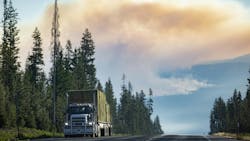Vaughn: Safe trucking in hurricane and wildfire seasons
Call it a “Rite of Fall.” August, September, and October of each year bring hurricanes and tropical storms to the Gulf and Southeast, while forest fires often ravage the West.
Truckers, drivers, and motor carriers alike are well-versed in perseverance and achieving their goals. But during natural disasters, completing the mission must take a back seat to safety. Here is what truck drivers should do to stay safe in these conditions:
Prepare
The “Rite of Fall” is just as certain as winter snows and springtime flooding. Always check weather conditions before travel. Emergency alerts can be delivered to mobile devices. No one should be caught unprepared.
Watch for Emergency Declarations by the federal government, states, and localities. Look at state and federal websites for road closures and detours. Travel may take extra time. Emergency declarations commonly allow truckers hours of service exemptions during these conditions, but first find out whether that extra time allows you to safely reach a secure destination.
Both company dispatchers and drivers should have access to weather and road information. When in doubt or when facing unforeseen dangers, truck drivers should pull safely off the road before calling back to the office. Drivers should always carry the food, tools, and clothing appropriate to the season.
See also: How fleets should prepare for adverse weather
Coordinate with emergency officials
Whether it’s law enforcement, first responders, fire crews, or other emergency officials, someone will be holding up traffic, shutting down roads, and dictating detours.
Truck drivers must be patient and await their directions and approval to proceed. Simply put, the officials stopping traffic did not create the natural disaster; they are just trying to get everyone through safely. Truckers share a common goal: safety.
Proceed with caution
During natural disasters, road conditions can change in an instant. Uprooted trees can fall. Bridges can be submerged by rushing waters. Rocks and snow can avalanche onto highways. Smoke can destroy all visibility.
These changes can occur before emergency officials put up warning signs or close roads. That means the responsibility for safe travel falls, as it always does, squarely on the shoulders of the truck driver. Truck drivers must be especially alert and be prepared to stop and warn others of dangers ahead.
Prepare, coordinate, and proceed cautiously. That is the prescription for safe trucking in natural disasters, whether it is during the “Rite of Fall” or anytime.
About the Author
Steve Vaughn
Senior Vice President of Field Operations
Steve Vaughn is senior vice president of field operations at PrePass Safety Alliance, the provider of PrePass weigh station bypass and electronic toll-payment and management services. Vaughn served nearly three decades with the California Highway Patrol and is a past president of the Commercial Vehicle Safety Alliance.
